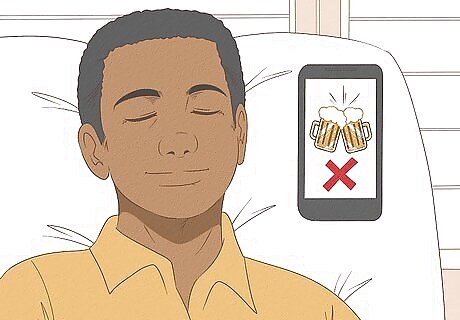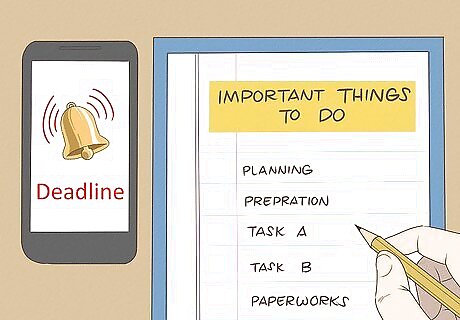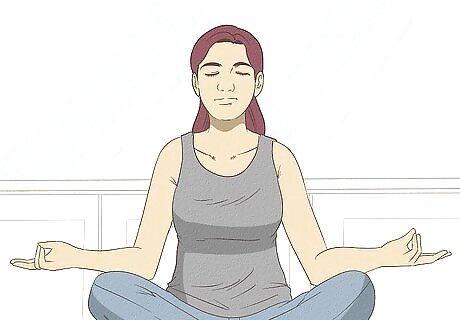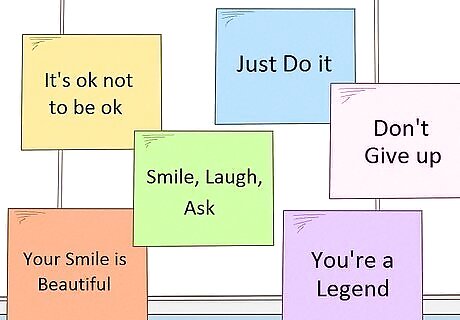
views
Approach life with an optimistic attitude.

Your problems don’t seem as bad when you see the glass as half-full. Let’s say that you’re stuck in a long line at your local coffee shop. Instead of reacting with frustration, treat the situation as an opportunity to get caught up on your email, or to play your favorite phone game for a few minutes. Transforming your problems into something positive is a great way to make them disappear! If your friend cancels your Friday-night plans at the last minute, use your freed-up evening as an opportunity to relax and unwind at home. If your favorite take-out place messes up your order, use the experience as a chance to try a new food or flavor combination.
Adjust your thinking habits to be less negative.

Over time, you can practice turning negative thoughts into positive ones. Start by identifying your negative thought patterns. Maybe you focus on only the bad things that happen during the day or punish yourself for things that aren’t your fault. You might even assume the worst for no reason, and view success from an all-or-nothing standpoint. As you pinpoint these negative thoughts, try replacing them with a positive alternative. Here are a few ideas to get you started: My alarm went off late, and now my whole day will be bad. It stinks that I didn’t wake up on time, but now I have the rest of the day to make things better! I’ll never improve at this. This is definitely tricky, but I’ll get better if I just keep at it. This will never work. It might not work, but I’ll never know if I don’t try. Always treat yourself the same way that you’d treat a close friend or trusted loved one. You wouldn’t say something mean and discouraging to them, right? Apply the same logic and kindness to your own thoughts.
Apply positive changes to negative parts of your life.

Small amounts of positivity can make a big difference in the long run. Start by identifying the aspects of your routine that you feel pretty negative about, whether it’s your car ride to work or the first few hours of your school day. Tackle one negative element at a time by giving it a positive spin. You might: Listen to your favorite podcast on the radio so you look forward to your daily commute Bring your favorite energy drink to work as a pick-me-up Make your favorite meal the night before so you don’t have to stress around dinnertime
Change your perspective when you look at a problem.

Ask yourself if this issue will be important in the future. Instead of magnifying the problem, pretend you’re looking at the issue from a month or year in the future. In some cases, this stressor won’t matter in the long term and isn’t worth panicking about in the present. Here are a few questions you might ask yourself: Is this problem worth the energy and stress that I’m putting into it? Three months from now, will this problem matter at all? Do I have any need to get upset about this?
Live in the present.

Living in the present helps you focus on what you can control. Our brains love to take a detour on the “what if” train, where we imagine the absolute worst possible scenarios. The next time you’re asking yourself these catastrophizing “what if” questions, ask yourself what purpose they serve in your life. Chances are, these thoughts only add to your stress and worries, and are completely out of your control, anyway. Try not to dwell on the past, either! There’s no point in focusing on unchangeable memories and events.
Set realistic expectations.

Expecting the world of yourself can lead to unnecessary stress and problems. Instead, write down the most important things that you need to get done, and when they need to be done. Then, ask yourself how much you can comfortably get done on your own. Make sure that your to-do list lines up with this comfort level, and ask a friend or colleague for a helping hand if it seems like too much to handle on your own. Try not to be a perfectionist, either–this can make your to-do list way more stressful and unwieldy. Just focus on doing a good job, not a perfect job.
Create a plan of action for your common sources of stress.

Identifying your most common stressors can help prevent future hardships. Are there any frequent problems or struggles that seem to trip you up? Think about what stresses you out the most during the week, and try to create a plan of action that can ease that stressor. You might: Make a detailed to-do list for yourself if you tend to procrastinate Set phone reminders if you often forget deadlines Use a timer to improve your time management skills
Tackle stressful situations with visualization.

Visualization helps you “practice” responding to a stressful task or situation. Maybe you have to make a big presentation to your supervisor, or you’re preparing to confront a friend about their toxic behavior. Whatever the case, it helps to give yourself a “test run” by picturing yourself walking through that stressful scenario, where you can imagine yourself doing and saying everything properly. This is a great way to improve your self-confidence while viewing the situation in a more realistic, manageable light. You might walk yourself through a workplace presentation, going over every important point. During this visualization, picture yourself speaking clearly and confidently, and answering your supervisor’s follow-up questions with ease. You could pretend that you’re face-to-face with a negative friend, walking yourself through exactly what you plan on saying. In your imagination, picture yourself speaking calmly, confidently, and steadily.
Practice gratitude every day.

You’ll feel happier and more problem-free if you focus on the positives in life. Spend a few minutes each day focusing on the good parts of your day and what you’re most thankful for. Regular, consistent gratitude sessions can help give your mental health a boost and help you feel better about life overall. Some people like keeping a gratitude journal, where they write down what they’re thankful for each day.
Vent to a trusted friend or loved one.

Sharing your struggles can help ease your stress and worry. Let a trusted friend or loved one know when you’re going through something tough, and take some time to explain what’s going on. Your confidante may offer you some advice, or just have some comforting words to share. In any case, venting your problems to a trusted individual is a great way to cope with and even minimize your struggles.
Exercise for 30 minutes each day.

Moving around is a great way to cut down your stress levels. Whenever you exercise, your body produces endorphins–these are hormones that help boost your mood. Any type of physical activity can do the trick, whether it’s taking your dog out for a walk, doing a little dance to your favorite song, or just going up and down some stairs. Choose an activity that fits your current fitness level, whether that’s walking around the block, jogging on the treadmill, or going for a long-distance run. Health experts agree that rhythmic exercise, like swimming, biking, running, and dancing, are extra helpful ways to let go of stress and feel less tense.
Meditate daily for 10-20 minutes.

A short round of meditation can help you better cope with stress. Set aside at least 10 minutes each day to chill out, unwind, and be alone with yourself. Spend this time either clearing your mind or focusing on uplifting, positive thoughts. With enough practice, regular mediation can be great for both stress relief and stress tolerance.
Practice regular self-care.

Caring for your physical and mental health is an important part of a problem-free life. Look for small ways to add self-care into your daily routine, whether it’s taking a moment to stretch, journaling for a few minutes, or crashing for a 15-minute cat nap. Here are a few other quick and easy ways to prioritize your physical and mental health: Watching a funny video on YouTube Unwinding in a warm bath Cleansing your social media feeds of toxic, unhelpful accounts Leaving uplifting notes for yourself around your home
Visit a therapist if life gets challenging.

A therapist can walk you through life’s challenges in a helpful, productive way. Sometimes, life may dish out a little more than you can handle–and that’s okay! There’s absolutely nothing wrong with turning to a licensed mental health professional for some extra help and support. Open up about what you’re struggling with, so your therapist can help walk you through possible strategies and solutions. If you aren’t comfortable meeting with a therapist one-on-one, think about joining a support group instead! It can be really comforting and validating to know that other people are going through the same struggles that you are.



















Comments
0 comment